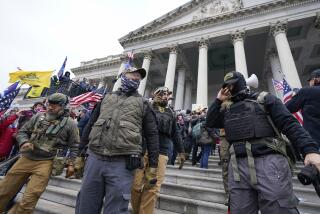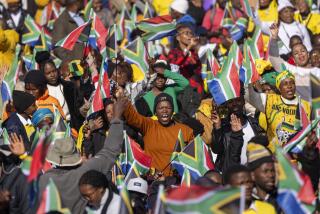COLUMN ONE : S. Africa’s New Brand of Terror : Pretoria’s far-right wing is increasingly using the violent tactics of black guerrillas to resist reforms. The white extremists are a painful problem for the police and the army.
- Share via
MAOKENG, South Africa — The pupils were taking recess at the far reaches of Cingo High School’s dirt playground a few days ago when two white men in a pickup glided slowly down the township street with the barrel of a shotgun sticking out of the passenger window.
Taylor Ntsuku, the smartest 16-year-old in school, was playing checkers. His friends huddled in conversation in the chilly wind. A few shared a cigarette. Nobody was paying much attention to anything outside the school’s seven-foot fence.
But with the first crack of gunfire, pupils dived for cover amid the sticker bushes. Ntsuku stood up to run, took the force of a second shotgun blast and fell backward, mortally wounded.
“He didn’t say anything,” his friend Awtie recalled. “He was barely breathing.”
Within minutes, on that rocky playground, the right-wing white backlash over President Frederik W. de Klerk’s reforms had taken another black life, the latest victim of the indiscriminate bombings, stonings and shootings that began countrywide five months ago.
The radical white right, long vocal but rarely violent, has undergone a dramatic transformation in recent weeks, emerging in no fewer than 69 separate organizations and adopting the revolutionary tactics once used by the African National Congress.
And South Africa’s police officers, accustomed to using the full force of the state against radical black guerrillas, are finding it more difficult to combat whites who are legally armed, army-trained and have been, until so recently, quiet, law-abiding citizens.
“These were friends of the police; they never gave us any problems,” said police Maj. Gen. Herman Stadler. “Now all of a sudden they want to overthrow the government, and we have to act against them. We’re having some success, but it’s difficult.”
The isolated attacks, carried out by small groups against black and liberal white targets, only hint at the trouble that may lie ahead, especially if the reform process and the impending release of ANC political prisoners force militant whites into organizing under a single banner.
“The flash point will be the transfer of power,” said Robert van Tonder, leader of the far-right Boer State Party. “The moment the day comes when De Klerk hands over power, then I won’t give a tuppence for his life.”
Although Van Tonder, for the record, disavows attacks on civilians and most property, he admitted in an interview that “it helps a lot. It scares the hell out of the government. They are losing control. And the right wing hasn’t really started.”
In the past two months, right-wing extremists have bombed two offices of De Klerk’s ruling National Party, two black labor union offices and the office of a liberal Afrikaans-language weekly newspaper, Vrye Weekblad.
They have tossed a grenade into a crowded Johannesburg tavern, killing one black man and injuring 21; planted a bomb at a black taxi stand, injuring 27, and carried out a variety of drive-by attacks on blacks. At least six people have died so far.
To counter the threat, police have raided homes of right-wingers, uncovered large caches of weapons and explosives and detained 27 whites, holding them in solitary confinement without legal representation under the same security law once used almost exclusively against black political activists.
About a dozen whites have been charged with weapons violations and a few with attempted murder.
Right-Wing Protests
The crackdown has raised cries of foul from the right.
“What has democracy come to in this country?” Van Tonder asked. “You suddenly feel like anybody can be taken into custody at any time.”
Several dozen police officers showed up at Van Tonder’s farmhouse north of Johannesburg before dawn recently and conducted a search of his papers while he and his wife, still in their pajamas, watched. Van Tonder said the officers seemed to sympathize with him and one confided: “We’d rather be raiding the ANC offices.”
Van Tonder served them coffee.
The authorities were looking for clues to the whereabouts of Van Tonder’s deputy, Piet (Skiet) Rudolph, the “Robin Hood” of right-wing South Africa. Rudolph, whose nickname means “to shoot,” is a balding former security policeman with a thick white beard. He has been on the run since April for allegedly staging an arms theft at an air force base. Several air force officers have been charged in that case.
Rudolph also has proudly claimed responsibility (he even signed an affidavit) for the May bombing of Melrose House, a Pretoria museum where the Afrikaners surrendered to the British in 1902 at the end of the Boer War. For that act, Rudolph has won wide acclaim among right-wing whites.
“The whole nation is hiding this man,” one right-wing leader said. “He’s a hero.”
In a videotape that Rudolph released to newspapers in June, he called for whites to rise up and stage a coup d’etat. “There is no time to plan a counterrevolution,” said Rudolph, flanked by guards in ski masks carrying automatic weapons. “It is now open war.”
When Law and Order Minister Adriaan Vlok saw the videotape, he posted a 50,000-rand ($20,000) bounty on Rudolph’s head. But Rudolph has yet to be found.
Secret Allies
Anti-apartheid groups contend that rank-and-file police officers have shown little enthusiasm for fighting white terrorism. Even right-wing groups agree that most of the police force and army are secretly on their side.
Gen. Stadler denies any police bias, pointing out that new police rules forbid officers to belong to political parties or organizations that advocate violence.
“We have been accused of hiding Piet (Rudolph), which is just not true,” Stadler said. “They have so many people who can hide him.”
And he says that fighting right-wing crime is, in some ways, more difficult than fighting left-wing terrorism.
“We are dealing with a different kettle of fish,” Stadler said. “You aren’t as suspicious of whites, they can get around much easier, and they have a fairly large following, especially in the countryside.”
They also are better armed, better trained, have ready access to more weapons and explosives and are, unlike the ANC guerrillas of previous years, allowed to operate legally inside the country. South Africa’s 2 million white adults hold licenses for more than 2 million guns. And nearly every white male under 35 has spent at least two years in the armed forces, often in combat.
The tactics and strategy of the white extremists resemble those of the ANC’s 30-year guerrilla campaign, which was recently suspended, “but the intensity and level of sophistication of the right-wing revolution is far more advanced,” said Wim J. Booyse, a political consultant in Pretoria who recently completed an undercover investigation of the right wing.
“These right-wingers have already, in the space of five months, gone into the armed phase and jumped into indiscriminate terror,” Booyse added.
So far, the violence has been carried out mostly by small groups, without evidence of any grand plan. But political analysts think the right-wing movement could probably muster an army of 40,000 men--much larger than all the black liberation armies in South Africa combined.
The emergence of far-right terrorism can be traced to De Klerk’s Feb. 2 decision to lift the ban on the ANC, the South African Communist Party and other black liberation organizations. It was the first clear sign that De Klerk was serious about granting the black majority a vote and abolishing apartheid.
Now the agreement between the ANC and the government to begin freeing political prisoners and granting freedom from prosecution to ANC guerrillas in exile is making right-wing whites especially nervous.
De Klerk’s white opponents fear that a one-man, one-vote political system, in a country where blacks outnumber whites 5 to 1, will mean the end of their Afrikaner culture and language.
Assassination Target
About half of South Africa’s 5 million whites are Afrikaners, also called Boers (farmers). These descendants of the country’s 17th-Century European settlers have controlled the South African government for most of this century and, as strict Calvinists, many still believe that the Bible preaches against “racial mixing.”
De Klerk’s vow to end Afrikaner dominance has made him the instant enemy of many of his fellow Afrikaners and, some fear, a target for assassination.
“If they are going to continue selling us out to the communists, they can expect more blasts,” Andrew Ford of the Boer Resistance Movement said after the explosion at one of the National Party offices. “They cannot expect people to sit quietly and accept what they are doing.”
Most right-wing whites, including many leading intellectuals, want the government to divide the country into separate areas and grant Afrikaners their own “homeland,” such as they had before the Boer War.
“It’s not guys playing cowboys and Indians,” said Booyse, the political consultant. “These guys see this as a just war, a war for survival.”
But pulling out a chair for white extremists at the negotiating table will not be easy. Both the ANC and the government refuse to consider dividing up the country, and most right-wing organizations won’t negotiate if the ANC is at the table.
For now, most conservative whites are trying to use their political clout to force De Klerk’s party out of office. The Conservative Party, the only right-wing party in Parliament, collected 600,000 votes in last year’s election, representing about one-fourth of all whites, and the party says it is growing.
But it lacks the votes to force a new election, and it also runs the risk of losing supporters as more whites turn to violence.
“A large part of the right wing’s support is among people who think of themselves as respectable, Christian, civilized people,” said Andre du Toit, a professor of political studies at the University of Cape Town. The moment right-wing violence threatens the country’s stability, he said, “it may drive a substantial part of their support base back to the National Party.”
The Conservative Party and its militant members still wield considerable influence in South Africa’s heartland, especially in small farming and mining towns. Right-wing organizations in some towns conduct armed patrols to force blacks off white neighborhood streets.
Black leaders here in Maokeng, in the rural Orange Free State, have applied seven times for permission to hold a peaceful protest march in the township. While similar applications throughout South Africa are routinely approved, the magistrate in Kroonstad, the white town that controls Maokeng, has always refused.
And the racial tensions grow. In Senekal, 50 miles from Maokeng, a 13-year-old boy was killed recently by a stone thrown by a white teen-ager riding in the back of a pickup. No arrests have been made.
Taylor Ntsuku’s death appeared to be an act of revenge. It began when some young blacks set fire to an electrical company’s pickup in the street outside the school. A day later, two men dressed in khaki returned to the scene and opened fire on schoolchildren as they drove past the playground.
The police found the men and questioned them. The men claim that the children were throwing rocks at their pickup. The children deny it. And the white investigating officer figures it was a case of self-defense.
An arrest in the case is unlikely, police say.
More to Read
Sign up for Essential California
The most important California stories and recommendations in your inbox every morning.
You may occasionally receive promotional content from the Los Angeles Times.











